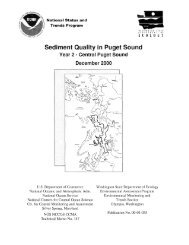Hydrographic Surveys Multibeam Echosounder Calibration ... - NOAA
Hydrographic Surveys Multibeam Echosounder Calibration ... - NOAA
Hydrographic Surveys Multibeam Echosounder Calibration ... - NOAA
You also want an ePaper? Increase the reach of your titles
YUMPU automatically turns print PDFs into web optimized ePapers that Google loves.
On DN 49 while alongside in Frederiksted the vessel took on fuel and water. The<br />
transducer draft measurement (z-value for Swath 1) in the VCF was based on a fully<br />
loaded vessel. The pole mounting the sonar was marked off in decimeter graduations<br />
from the transducer face. This allowed the Hydrographer to determine, to within a<br />
centimeter or two, the waterline setting. Readings of the waterline were observed when<br />
the pole was deployed. Post fueling, the draft of the Reson sonar unit measured 3.44<br />
meters, and the distance from the waterline to RP measured 1.87 meters. This showed a<br />
difference of .127 meters lower in the water prior to taking on fuel and water. Waterline<br />
corrector values were added into the vessel configuration file is CARIS.<br />
Static Draft Correction (meters)<br />
Dynamic Draft Survey<br />
(Vessel waterline with respect to vessel reference frame and vessel speed)<br />
No dynamic draft survey was conducted for this vessel.<br />
<strong>Calibration</strong> Area<br />
Site Description<br />
On February 18, 2004 prior to the start of survey operations a comparison between the<br />
multibeam and single beam systems was conducted alongside the pier in Old San Juan,<br />
PR. The ships single beam sonar (Abyss IES-10) measured a depth of 25.2 ft., and the<br />
multibeam nadir beam measured 24.7 ft. The estimated draft of the ships singlebeam<br />
transducer was 10 ft. The measured draft of the multibeam unit was 11 ft 2 inches. The<br />
calculated comparison was 35.2 ft (SB) – 35.9 ft (MB) = a difference of 0.7 ft. This<br />
general agreement gave the Lead Hydrographer, at least some confidence in the<br />
multibeams proper installation and operation. A more detailed comparison was not<br />
possible due to the not knowing the actual draft of the ships single beam transducer.<br />
The Nancy Foster patch test was started on February 18, 2004 (DN 49) at 17°39'32.27" N<br />
064°55'06.92" W; (296475.05, 1953489.27), south west of Frederiksted, St. Croix. Water<br />
depths at the site ranged from 17-256 meters. The bathymetry of the site consisted of two<br />
main components. The first was a steep slope (75 deg) in water depths ranging from 57<br />
174 meters. The second was a relatively flat area, with depths of approximately 20<br />
meters. A successful patch test was not able to be conducted due to several factors<br />
including site selection (the water depths exceeding sonar system limitations), lack of<br />
time to run all the lines, and the vessel not being on line due to helm/OOD inexperience.<br />
Despite this lines run on DN 49 were deemed sufficient to determine the roll bias error.<br />
All other values were determined using later patch test data.







